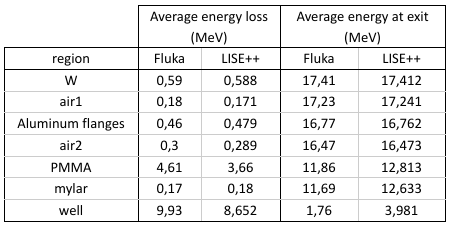Dear @msacrist,
Apologies for the late response. I have indeed done the verifications, as well as produced some new results.
Geometry and materials are identically defined in both Fluka simulations, as well as in SRIM and LISE++. Beam divergence and size should also be comparable.
Taking all these factors into consideration, I have configured USRBDX detectors for every interface between consecutive regions and calculated the average energy loss in each region. I compared the results with those obtained from SRIM/LISE++. Minor differences are apparent for each region, but significant disparities are evident in PMMA. It is noticeable that the energy loss in PMMA predicted by Fluka is 1 MeV higher than that predicted by SRIM, despite nearly identical energy at entry. My assumption is that this disparity also contributes to differences in the subsequent media, ultimately resulting in a significant discrepancy in the predicted energy at the well-water interface.

I have recently also read this post and was pondering whether I may also find myself in a gray region in regard to the physical models employed by Fluka. I wonder if this particular problem may also be caused by problematic handling of these intermediate energy protons interacting with light nuclei.
Thank you,
Andrei Hotnog